|
Email / CV / LinkedIn / Google Scholar / Github I am a PostDoc at the Music Cognition Group in the Institute for Logic, Language and Computation (ILLC) in the Fair Remuneration Project supervised by Dr. Ashley Burgoyne. I will be working on the explainability of generative AI music models and enhancing fair compensation for artists whose music has been used as an inspiration for the AI model to generate new songs. I was a PhD student at the University of Amsterdam, where I worked on Hierarchical Knowledge in Multimodal Representation Learning. My research was jointly supervised by Prof. Dr. Paul Groth (INDE Lab) and Dr. Pascal Mettes (VIS Lab). During this time, I completed a research internship at Apple Machine Learning Research, where I collaborated with Hanlin Goh on self-supervised pretraining of transformers using relative patch transformations. Prior to my PhD, I earned a Master’s degree in Artificial Intelligence from the University of Amsterdam. During this time, I interned at Dexter Energy Services weather nowcasting using satellite imagey. My master’s thesis, conducted in collaboration with TomTom, focused on object detection under high class imbalance. I hold a Bachelor’s degree in Computer Science with a focus on Information Technology from the University of Tehran. During my undergraduate studies, I completed a research internship at ETH Zurich at the Computational Social Science Lab, where I worked on large-scale distributed systems (DIAS & EPOS) with an emphasis on data management. |
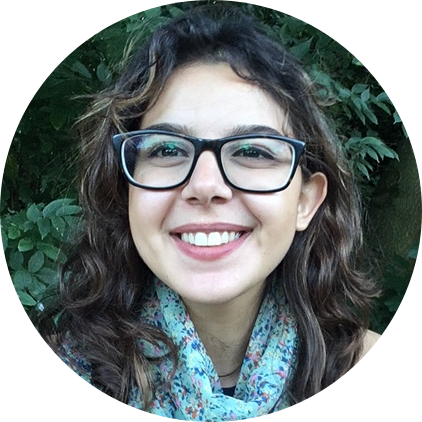
|
|
I'm interested in computer vision, and specifically multimodal data such as video, audio, text and graph. I would like to work on improving high-level understanding of videos such as object-centric learning and relationship detection and easing retrieval by storing information in a knowledge graph. I'm currenlty working on a project to learn better instance-level represetations using prior knowledge. |

|
Designing Hierarchies for Optimal Hyperbolic EmbeddingMelika Ayoughi, Max van Spengler, Pascal Mettes and Paul Groth Published at ESWC2025 conference, 2025 eswc website / paper / code / slides / video / poster /  Nominated for Best Research Paper Award
Nominated for Best Research Paper Award
Hyperbolic geometry has shown to be highly effective for embedding hierarchical data structures. As such, machine learning in hyperbolic space is rapidly gaining traction across a wide range of disciplines, from recommender systems and graph networks to biological systems and computer vision. The performance of hyperbolic learning commonly depends on the hierarchical information used as input or supervision. Given that knowledge graphs and ontologies are common sources of such hierarchies, this paper aims to guide ontology designers in designing hierarchies for use in these learning algorithms. Using widely employed measures of embedding quality with extensive experiments, we find that hierarchies are best suited for hyperbolic embeddings when they are wide, and single inheritance, independent of the hierarchy size and imbalance. |
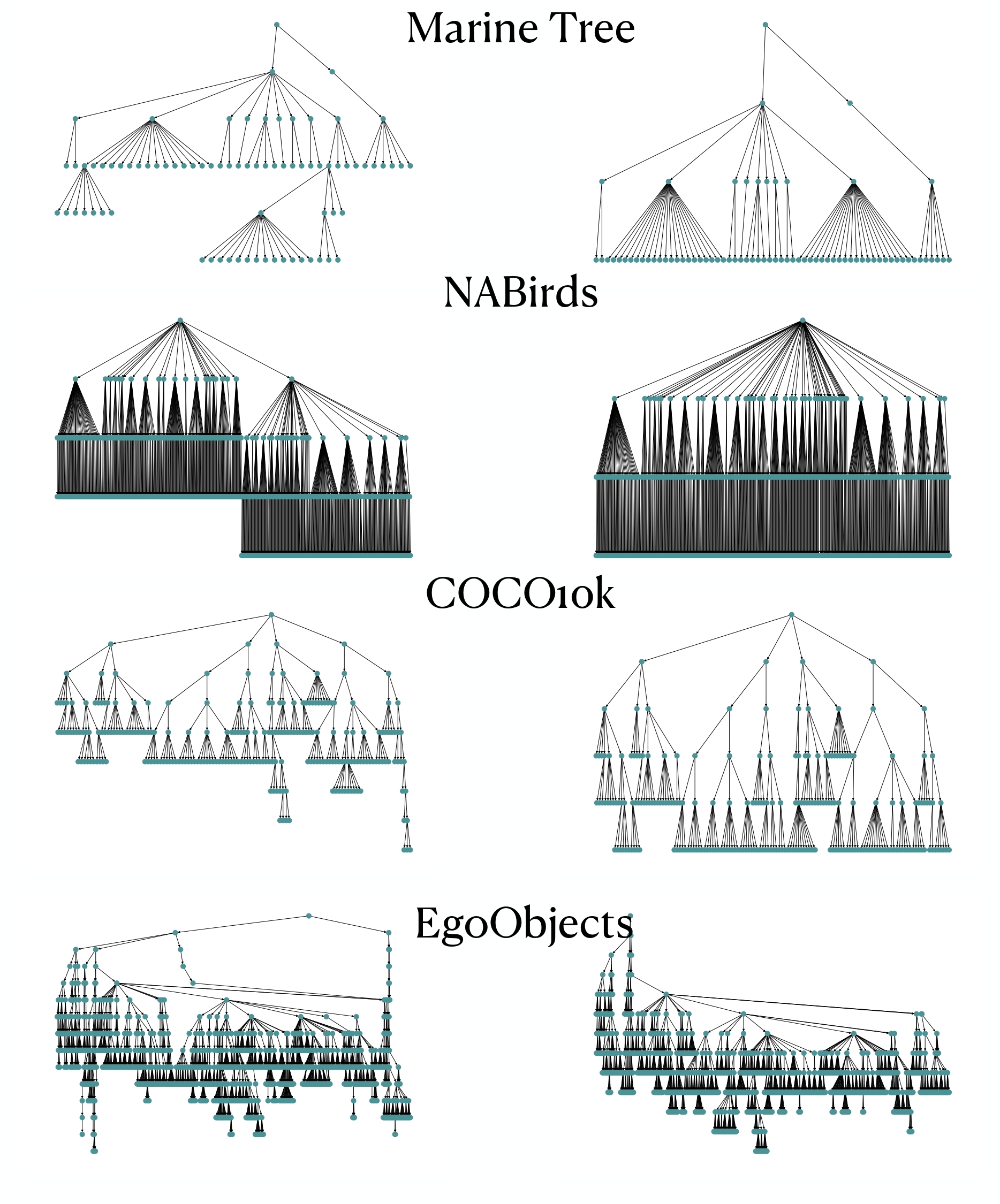
|
Minimizing Hyperbolic Embedding Distortion with LLM-guided Hierarchy RestructuringMelika Ayoughi, Pascal Mettes, Paul Groth Accepted to KCAP Conference, 2025 paper / code / arxiv / Hyperbolic geometry is an effective geometry for embedding hierarchical data structures. Hyperbolic learning has therefore become increasingly prominent in machine learning applications where data is hierarchically organized or governed by hierarchical semantics, ranging from recommendation systems to computer vision. The quality of hyperbolic embeddings is tightly coupled to the structure of the input hierarchy, which is often derived from knowledge graphs or ontologies. Recent work has uncovered that for an optimal hyperbolic embedding, a high branching factor and single inheritance are key, while embedding algorithms are robust to imbalance and hierarchy size. To assist knowledge engineers in reorganizing hierarchical knowledge, this paper investigates whether Large Language Models (LLMs) have the ability to automatically restructure hierarchies to meet these criteria. We propose a prompt-based approach to transform existing hierarchies using LLMs, guided by known desiderata for hyperbolic embeddings. Experiments on 16 diverse hierarchies show that LLM-restructured hierarchies consistently yield higher-quality hyperbolic embeddings across several standard embedding quality metrics. Moreover, we show how LLM-guided hierarchy restructuring enables explainable reorganizations, providing justifications to knowledge engineers. |
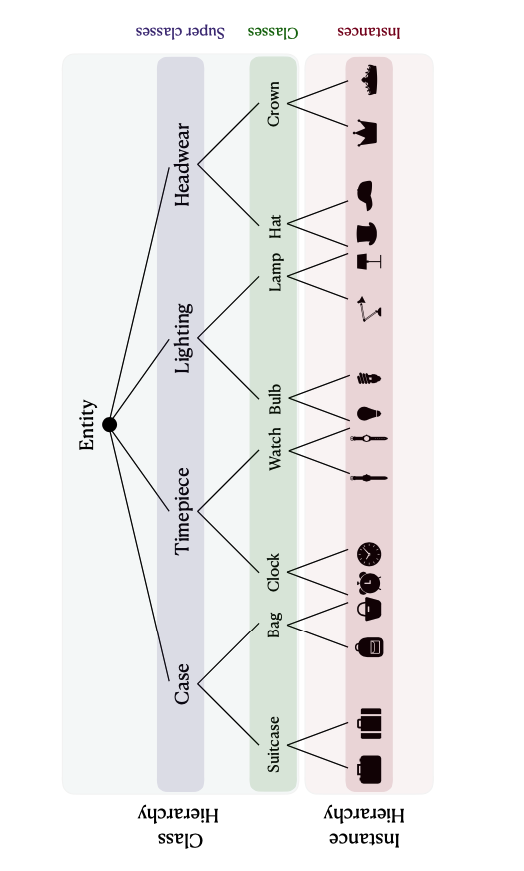
|
Continual Hyperbolic Learning of Instances and ClassesUnder review, 2024 arxiv / Instance-level continual learning addresses the challenging problem of recognizing and remembering specific instances of object classes in an incremental setup, where new instances appear over time. Continual learning of instances forms a more fine-grained challenge than conventional continual learning, which is only concerned with incremental discrimination at the class-level. In this paper, we argue that for real-world continual understanding, we need to recognize samples both at the instance- and class-level. We find that classes and instances form a hierarchical structure. To enable us to learn from this structure, we propose a hyperbolic continual learning algorithm for visual instances and classes. We introduce continual hyperbolic classification and distillation, allowing us to embed the hierarchical relations between classes and from classes to instances. Empirical evaluations show that our method can operate effectively at both levels of granularity and with better hierarchical generalization, outperforming well-known continual learning algorithms. |
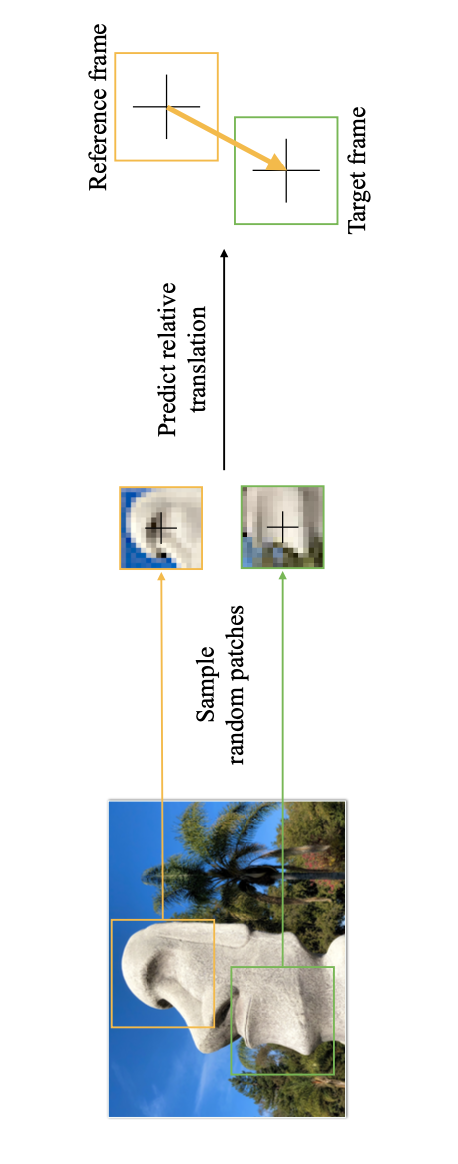
|
How PARTs Assemble into Wholes: Learning the Relative Composition of ImagesMelika Ayoughi, Samira Abnar, Chen Huang, Chris Sandino, Sayeri Lala, Eeshan Gunesh Dhekane, Dan Busbridge, Shuangfei Zhai, Vimal Thilak, Josh Susskind, Pascal Mettes, Paul Groth, Hanlin Goh Published at PMLR, Accepted to NLDL Conference, 2025 Preprint / code / arxiv / Images are often composed of objects and object parts that are related to each other but are not necessarily related to their absolute position in the image frame. For instance, the pose of a person's nose is consistent relative to the forehead, while that same nose can be anywhere in absolute position in the image frame. To capture these underlying relative relationships, we introduce PART, a novel pretraining approach that predicts pairwise relative translations between randomly sampled input patches. Through this process, the original patch positions are masked out. The pretraining objective is to predict the pairwise translation parameters for any set of patches, just using the patch content. Our object detection experiments on COCO show improved performance over strong baselines such as MAE and DropPos. Our method is competitive on the ImageNet-1k classification benchmark. Beyond vision, we also outperform baselines on 1D time series prediction tasks. The code and models will be available soon. |
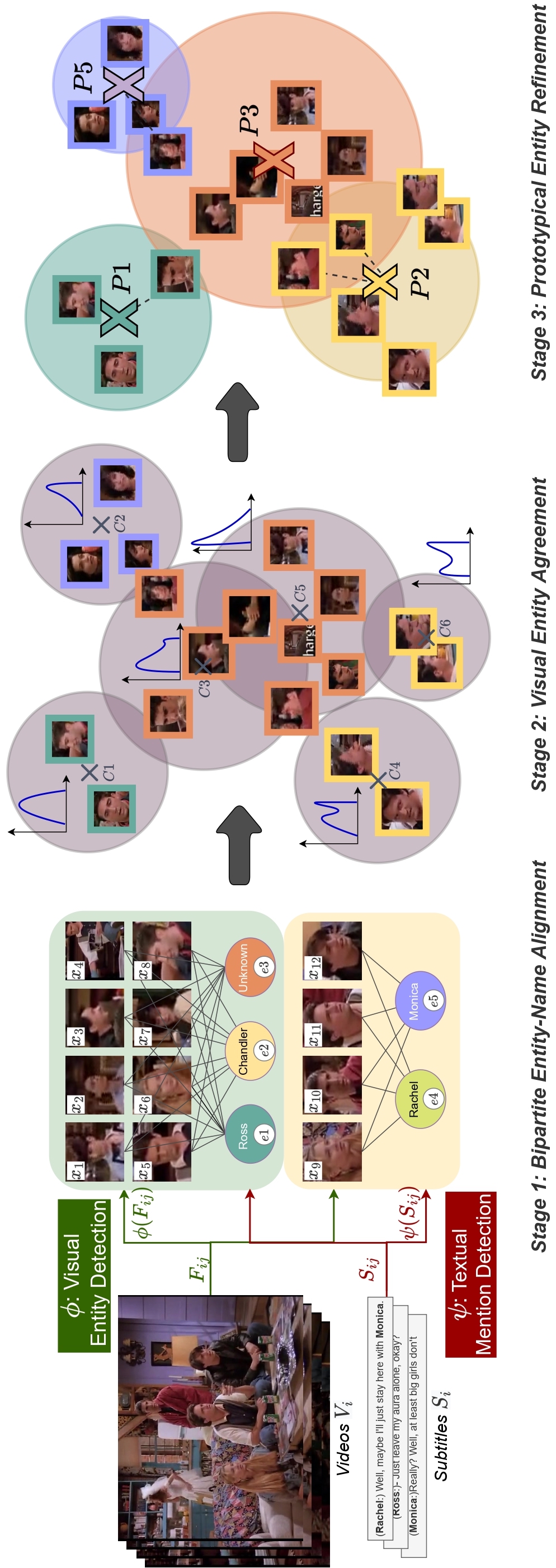
|
Self-Contained Entity Discovery from Captioned VideosMelika Ayoughi , Pascal Mettes, Paul Groth Published at TOMM journal, 2022 paper / arxiv / code / slides / This paper introduces the task of visual named entity discovery in videos without the need for task-specific supervision or task-specific external knowledge sources. Assigning specific names to entities (e.g. faces, scenes, or objects) in video frames is a long-standing challenge. Commonly, this problem is addressed as a supervised learning objective by manually annotating faces with entity labels. To bypass the annotation burden of this setup, several works have investigated the problem by utilizing external knowledge sources such as movie databases. While effective, such approaches do not work when task-specific knowledge sources are not provided and can only be applied to movies and TV series. In this work, we take the problem a step further and propose to discover entities in videos from videos and corresponding captions or subtitles. We introduce a three-stage method where we (i) create bipartite entity-name graphs from frame-caption pairs, (ii) find visual entity agreements, and (iii) refine the entity assignment through entity-level prototype construction. To tackle this new problem, we outline two new benchmarks SC-Friends and SC-BBT based on the Friends and Big Bang Theory TV series. Experiments on the benchmarks demonstrate the ability of our approach to discover which named entity belongs to which face or scene, with an accuracy close to a supervised oracle, just from the multimodal information present in videos. Additionally, our qualitative examples show the potential challenges of self-contained discovery of any visual entity for future work. |
|
|
| October 2020-Now: Mentor at the inclusive AI program |
| October 2020-July 2023: Organization team of the inclusive AI program |
|
|
| Nov 2025: Guest Lecture at Advanced Neural and Cognitive Modelling, MSc Brain & Cognitive Sciences UvA. [Slides] |
| Nov 2024: Master AI Thesis Supervision |
| Nov 2023: Master AI Thesis Supervision |
| Nov 2022: Master IS(DS) Thesis Supervision |
| April 2022: Bachelor AI Thesis Supervision |
| November 2022: Teaching Assistant Applied Machine Learning at UvA |
| November 2021: Teaching Assistant Applied Machine Learning at UvA |
| November 2020: Teaching Assistant Applied Machine Learning at UvA |
| September 2019: Teaching Assistant Machine Learning 1 at UvA |
| 2014-2017: Teaching Assistant of Discrete Mathematics, Introduction to Computing Systems and Programming, Data Structures, Artificial Intelligence, Algorithm Design and Computer Networks at UT |